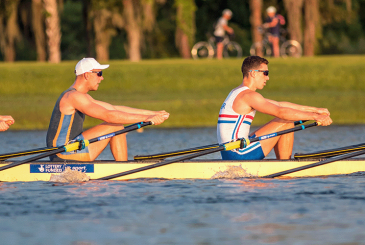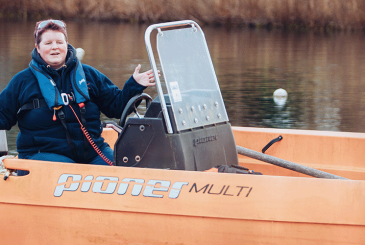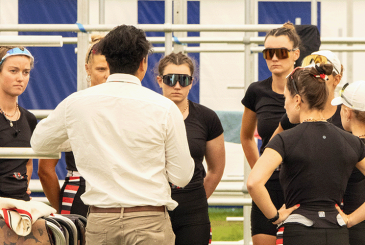Just being coached may not make you row better – it’s how you use the coaching that really matters, says Robin Williams
In this article I’m looking at feedback from the coach and how you can be a fast learner. Of course not everyone has a coach and even if you do there are often times when you are on your own, so it’s important to understand technique for yourself and be able to work on your points with, or without, the coach.
A key point – many athletes wrongly assume that simply being coached will make them better. They make it a passive process, hear what is said but change little. Some even positively avoid being coached; they take it personally, feel embarrassed in front of their crew-mates and would rather be left alone! Small wonder that they waste years rowing in exactly the same way. So a good athlete will take responsibility for his own technique as much as his own training and realise that change comes from within. You use coaching to help the process not be the process.
TIP
You spend years out there on the water; invest 20 minutes sitting with the coach to talk about and agree the technical model you are trying to use. Get on the same page to start with!
Change is not easy. No-one likes trying and failing but failing is essential to learning, just as success reinforces a good change. In fact you need to be a bit of a masochist to really get on! Most successful athletes will ask to be criticised, pester the coach for feedback, make exaggerated changes. They realise that it’s not always about how hard you try so much as whether you are trying in the right way.
Let’s take an example.
The coach says you are using your upper body too much at the beginning of the stroke and wants you to use your legs more to initiate a connection from your blade through the muscle chain to the handle. If you have spent years rowing the blade in hard with your shoulders this will be your patterned learning and even if your brain says ‘change’ your muscles have deepseated movement patterns to un-learn and
re-learn in a new way. It’s bound to feel wrong to you.
You have learned a way to connect but it’s not the way the coach wants; and this may be the root of the conflict between coach and athlete. The rower usually deals with what it feels like, the coach with what it looks like. The coach will be after a mechanical improvement (e.g. stronger position, better angles, etc), the rower will want it to feel better – instantly. Ideally the coach achieves both.
TIP
Base your technique around some simple concepts and then develop the detail: e.g. Push before you pull; fix the spoon and lever the handle; use the big muscles first; boat speed is the result of power phase plus recovery phase, etc.
Once you have the right idea in your mind you can coach yourself a lot of the time and make really good use of the coach’s feedback when they are around. I’m sure it’s obvious by now that I think the key to good technique is in the mind; the doing is easy if you are thinking the right things.
Well, let’s now assume that you are a truly open-minded athlete switched to ‘receive’ mode and eager to listen and improve. That’s only the beginning. Some people seem to acquire skill very easily while others struggle. The well worn learning method is:
- Identify the fault
- Demonstrate the correct way
- Make the correction
- Repeat correctly 10,000 times!
In other words you need to get it right and then seal it in the muscle memory – a lot.
Occasionally you get those ‘light bulb’ moments. It happened once with a rising star I coached who one day really just ‘got it’. He said to me that he realised he was making it more complicated than it was, doing too many movements and not listening to the boat. I was delighted but really the breakthrough was entirely his own. Your own thoughts are 1000 times more meaningful to you than someone else’s.
For this athlete the breakthrough came from no single technical element. It was the holistic approach but there had been months of frustrating work on the individual elements of the stroke before that. He just put the pieces back together in a really good way and finally understood how each piece of the jigsaw fitted.
The great coach Harry Mahon used to ‘dismantle’ an athlete’s stroke, sometimes in a very determined and aggressive way. He even had one or two grown men in tears on occasion but the reason was to either win or force their acceptance of his concepts about the stroke, and some could be very resistant even though they said they wanted to get better! He wanted them to love the sport and learn the art, not just the science, of rowing so their belief in their technique was a weapon in itself.
TIP
Think of technique on a spectrum from 1-10 where 1 is totally wrong and 10 is perfect. It can work really well to occasionally do something deliberately wrong first because it reinforces the contrast when you do it well! For example, skying at the entry. Everyone misses a wee bit so try missing a whole one metre, then half a metre, then 20cm, then 5cm, then 1cm, then nothing at all.
Of course it takes time to get better – you can argue that technique is easy; it’s the skill of applying it under full race conditions which is the hard part. But time is also your enemy. I often use the spectrum idea here too and ask athletes: “can you make this change in one year? What about three months … next week … tomorrow … on the next stroke?”
After all, the decision is in your mind!
This article was first published in Rowing & Regatta magazine in January 2010.










